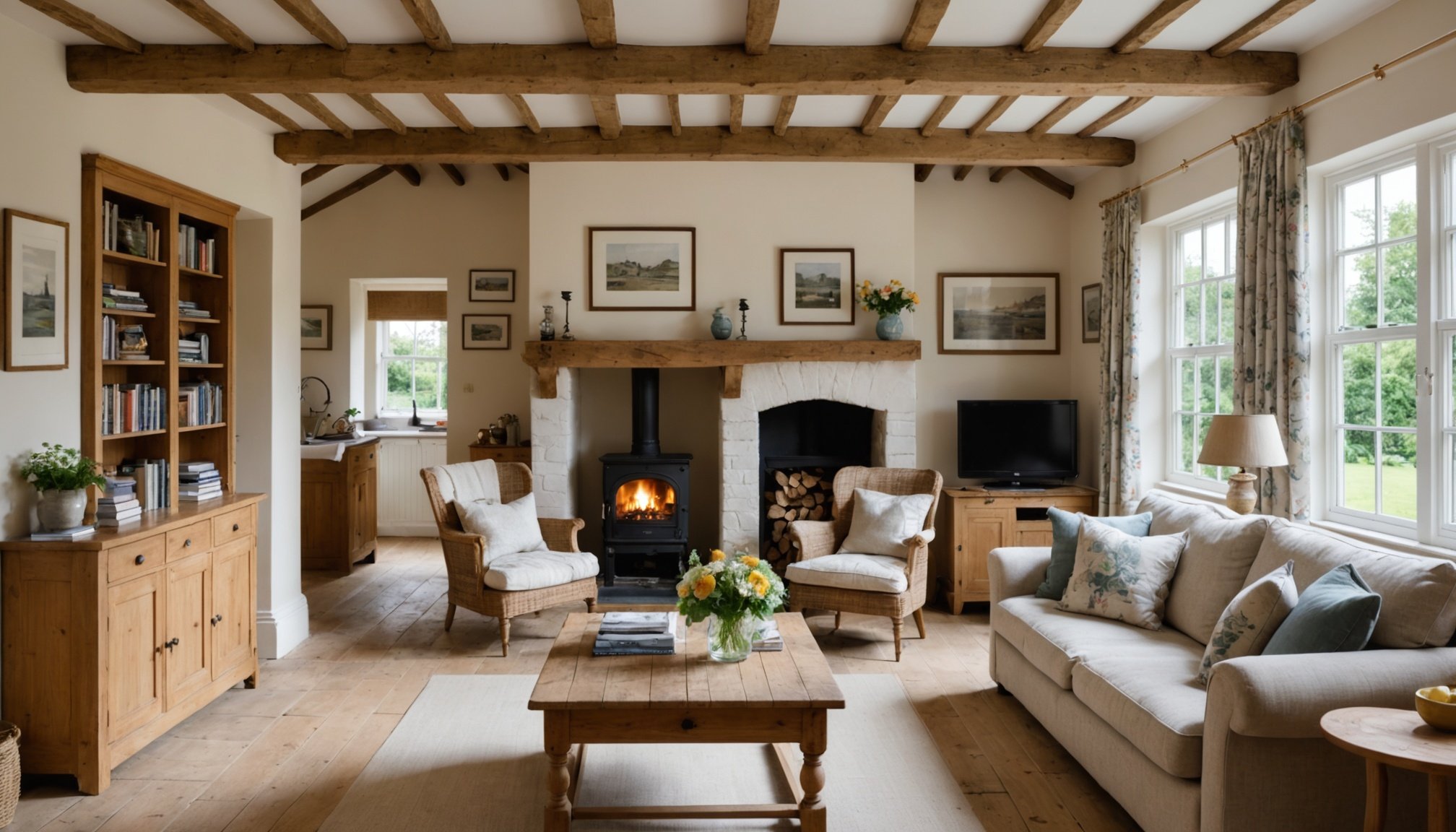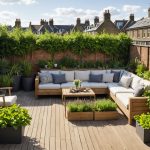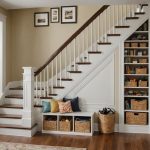Transforming a UK cottage into a charming open-plan living space can be both exciting and daunting. Balancing modern design with the building's inherent character is key. This guide explores creative strategies to retain historic charm while embracing contemporary functionality. Discover how thoughtful design choices can enhance light flow, unify spaces, and create a warm atmosphere. With the right approach, your cottage can be a harmonious blend of old-world charm and modern living.
Design Principles for Open-Plan Living Spaces
Open-plan design has become a popular choice in modern homes due to its ability to create a sense of spaciousness and connectivity. When considering interior design principles for open-plan spaces, it's crucial to focus on the flow and functionality of the area. This involves ensuring that different zones, such as the kitchen, dining, and living areas, are seamlessly integrated while maintaining their distinct purposes.
En parallèle : Transforming Your UK Basement Flat: Creative Ways to Enhance Appeal in Low-Light Spaces
Space optimization is another key aspect. This can be achieved by strategically placing furniture to define areas without obstructing pathways. For instance, a sofa can serve as a natural divider between the living room and dining area, promoting both separation and unity.
Color and lighting play significant roles in enhancing an open-plan layout. Light, neutral colors can make a space feel larger, while strategically placed lighting can highlight specific areas and create ambiance. Pendant lights over a dining table or spotlights in a kitchen can add both functionality and style.
Dans le meme genre : Unlocking Water Efficiency: Innovative Smart Tech Solutions for Homes in the UK
In summary, when designing an open-plan living space, consider the flow, functionality, and space optimization. Use color and lighting to enhance the environment, ensuring a harmonious and practical living area.
Successful Cottage Transformations
Exploring transformed cottages offers a wealth of design inspiration. These case studies showcase how traditional spaces can be revitalized with modern touches while retaining their unique charm.
Example 1: Modern Meets Traditional
In this transformation, the cottage's historic architecture was preserved, while modern elements were introduced to enhance functionality. Key features include:
- Open-plan living areas that maintain the cottage's rustic charm.
- Use of neutral color palettes to unify old and new elements.
- Contemporary lighting fixtures that complement traditional woodwork.
Example 2: Maximizing Space with Character
This cottage was reimagined to optimize space without sacrificing its character. Strategies involved:
- Multi-functional furniture to create versatile living areas.
- Clever use of vertical storage solutions.
- Retaining original architectural details, such as exposed beams, to add warmth.
Example 3: Blending Old and New
Here, the focus was on blending the cottage's historical aspects with modern comforts. Achieved by:
- Integrating modern appliances seamlessly into the kitchen.
- Using glass partitions to maintain an open feel while defining spaces.
- Preserving original stone fireplaces as focal points, adding both history and coziness.
These examples highlight how thoughtful design can breathe new life into cottages, offering a harmonious blend of tradition and modernity.
Maintaining Character in Open-Plan Designs
Preserving heritage while embracing open-plan designs can be a rewarding challenge. Integrating original materials is a key strategy, ensuring that the space retains its unique character. For instance, exposed brick walls or original wooden beams can be left intact, serving as focal points that celebrate the building's history.
The importance of architectural details cannot be overstated. These elements, such as ornate moldings or vintage fireplaces, add depth and authenticity to a space. They should be highlighted rather than overshadowed by modern additions. Consider using subtle lighting to draw attention to these features, enhancing their visual impact.
When choosing furniture and decor, it's crucial to select items that complement these historical elements. Opt for pieces that echo the era of the original features, such as mid-century modern furniture in a 1950s home. This creates a cohesive look that respects the past while incorporating contemporary comforts.
By thoughtfully combining character elements with modern design, you can achieve an open-plan space that is both functional and rich in history. This approach ensures that the charm of the original structure is not lost, but rather celebrated in a new, dynamic setting.
Balancing Modern Needs with Historical Aesthetics
Creating a home that marries modern design with historical preservation requires a thoughtful approach. It's essential to honour the building's past while ensuring it meets contemporary needs.
One effective strategy is to incorporate modern design elements that enhance functionality without overshadowing historical aesthetics. For example, sleek, minimalist furniture can complement ornate architectural details, providing a functional space that still respects its heritage.
When it comes to technology, innovations such as discreet smart home systems can be integrated subtly within a cottage aesthetic. Consider hidden wiring and compact devices that maintain the charm of traditional interiors while offering modern conveniences.
Multi-functional spaces are key in balancing these elements. By using versatile furniture, such as foldable tables or convertible sofas, you can create areas that serve multiple purposes without compromising on style. This approach ensures that each room remains practical and aesthetically pleasing.
To successfully blend contemporary comfort with traditional design, focus on maintaining a cohesive style. Select materials and finishes that echo the building's original features, ensuring a harmonious blend of old and new. This careful integration preserves the charm while meeting modern demands.
Practical Tips for Redesigning Your Cottage
Redesigning a cottage can be an exciting journey, blending renovation tips with personal touches. Begin with essential steps in planning your redesign. It's crucial to outline your vision and establish a timeline, ensuring each phase is meticulously planned. This helps in managing both expectations and resources.
Budgeting is a key factor. Allocate funds wisely, prioritising areas that require immediate attention. Sourcing materials for authenticity is vital; seek out reclaimed wood or vintage fixtures to maintain the cottage's charm. This not only preserves the historical essence but also adds a unique character to your project.
For those keen on DIY projects, there are numerous options to enhance both character and functionality. Consider refurbishing old furniture or creating bespoke storage solutions. These projects can infuse personal style while being cost-effective.
Incorporating design advice from professionals can offer fresh perspectives. They can suggest innovative solutions that align with your vision, ensuring a cohesive design. However, balancing professional input with personal creativity is essential to achieve a space that truly feels like home.
Visual Inspiration for Cottage Transformations
Visual inspiration is a powerful tool when embarking on cottage transformations. Before-and-after images serve as compelling evidence of the potential in redesign projects. They allow homeowners to visualise the drastic changes that can be achieved, providing a clear narrative of transformation. These images not only highlight the aesthetic evolution but also the functional improvements made to the space.
Design visuals play a crucial role in the planning phase. They offer a tangible representation of ideas, helping to refine concepts and align them with personal preferences. Inspiration galleries, filled with diverse styles and solutions, can spark creativity and guide decision-making. They provide a wealth of ideas, from colour schemes to furniture arrangements, ensuring a well-rounded approach to design.
Incorporating diagrams is essential for planning layouts effectively. They offer a detailed view of spatial arrangements, helping to optimise functionality while maintaining aesthetic appeal. Diagrams can illustrate the flow of space, ensuring that each area serves its intended purpose without compromising on style. By utilising these visual tools, homeowners can confidently navigate the complexities of cottage transformations, resulting in spaces that are both beautiful and functional.
Resources for Cottage Redesign Projects
Embarking on a cottage redesign journey can be both exciting and daunting. Fortunately, numerous design resources are available to guide you through the process. Recommended books, such as "The Cottage Book" by Carol Bass, offer a wealth of inspiration and practical advice. Online platforms like Pinterest provide endless visual ideas, helping you conceptualise your vision.
When seeking expert advice, consider engaging with professional architects and interior designers. They bring valuable insights and experience, ensuring your redesign aligns with both aesthetic goals and structural integrity. Websites like Houzz can connect you with professionals who specialise in cottage renovations, offering tailored solutions to meet your needs.
For those who enjoy community engagement, online forums and communities are invaluable. Platforms like Reddit's Home Improvement subreddit allow you to share experiences and gather feedback from fellow enthusiasts. These spaces foster a sense of camaraderie, providing diverse perspectives and innovative ideas.
Utilising a combination of these resources ensures a well-rounded approach to your cottage redesign, blending personal creativity with professional guidance. Whether you're a seasoned renovator or a novice, these tools offer the support needed to bring your vision to life.











